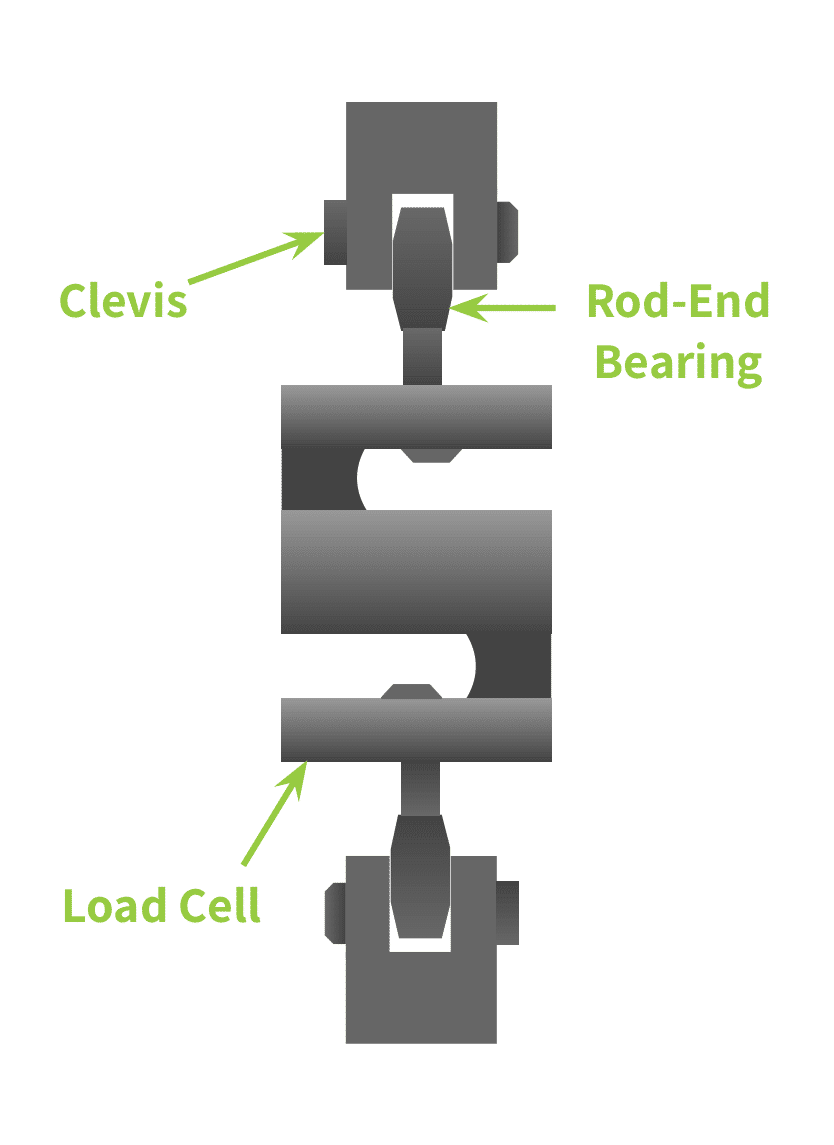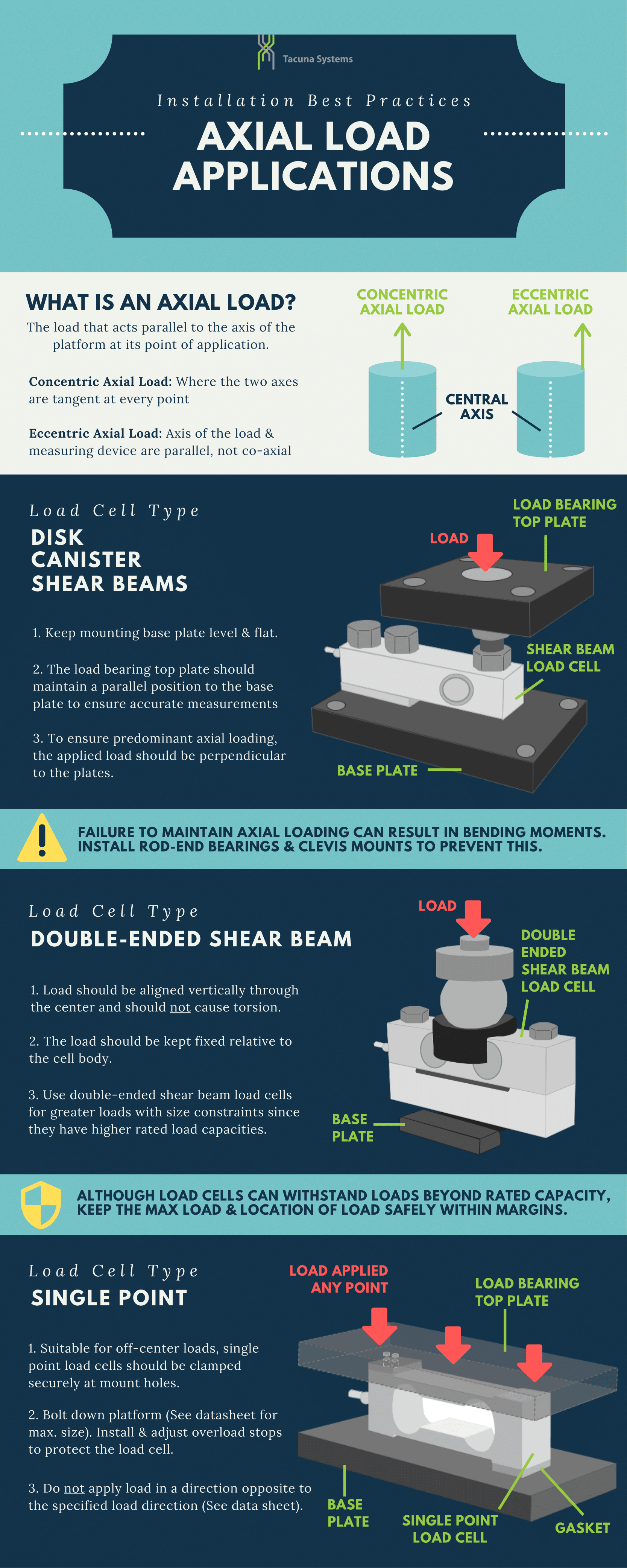
While choosing the best load cell of the highest quality is important for accurate measuring, its installation and mounting are equally important. Proper installation is critical to obtaining high-quality, accurate readings. It also guarantees ease of use and safe operations.
This article will give helpful load cell installation tips and important factors to consider. However it does not replace an installation guide. For best results, always follow the manufacturer’s installation instructions and ensure that installers are properly trained. We encourage you to contact Tacuna Systems to discuss any design or implementation issues specific to your project.
1) Choose The Right Frame and Fixture
Setting up the proper fixture (or load cell mount) and frame is critical to maximize load cell performance and maintain safe operating conditions. The article, A Comparison of Tacuna Systems Load Cell Mounts summarizes the features of each such mount we sell, to help with the selection process.
An optimal frame design should maximize stiffness but minimize weight and costs. The frame must be sturdy enough to support the maximum weight borne by the measuring device (including overload). It should also be rigid enough to withstand deformation and flexing. The supporting features to the structure should be rigid.
The fixture design should minimize unintended inputs from the surrounding environment. Vibrations, thermal expansion, mechanical deformation, and stray electrical current can cause false readings and damage to, or failure of, the load cell.
(a) Mitigating Vibration
A variety of sources can introduce vibrations that affect the fixture, including compressors, pumps, actuators, and engines. Additionally, ground vibrations from seismic activity can skew measurement results. Securing the frame to a hard, flat surface will reduce vibrations from passing vehicles and local equipment. To the extent that vibration mitigation is not possible, the measuring system should incorporate filters and software to compensate for the effect.
(b) Accounting for Thermal Expansion/Mechanical Deformation
Design the mounting frame to allow for unhindered thermal expansion or contraction. Load cell mounts that do not allow for mechanical expansion can cause permanent damage to the load cell or frame. To maintain a safe operating environment, always design for the appropriate amount of expansion clearance. Also build a frame that avoids the intrusion of ice, moisture and other weather-related factors that can cause corrosion or mechanical deformation.
(c) Avoiding Rotation
For suspended loads, the mounting frame should limit rotation to prevent hardware from loosening over time.
(d) Accounting for Other Forces
Particularly in outdoor environments, the support frame should account for other forces that can add loads to the system, such as wind.
(e) Avoiding Electrical Interference
The fixture and frame should not cause unintentional ground paths. Also, avoid welding the frame, fixture or mounts in the presence of installed load cells. Stray currents from welding can damage these sensitive components.
2) Align Loads in the Proper Direction
Ideally, in a measuring system all of the load or force will be transmitted through the load cell. If the measured force is not fully applied through the load cell’s intended axial direction, the measurement system won’t capture the correct reading. This axis is often clearly marked on the device and is typically perpendicular to the loading surface. Also, the load’s geometric center must be over the load point, not just aligned in the proper direction.
Misaligned loads can happen in two ways: (a) when the frame and mounts improperly guide the load; and (b) when any attached structures (such as supports, safety cables, pipes and hoses) create “force shunts.” This FAQ explains the effect of improperly guided loads on the load cell reading.
(a) Correctly Distribute and Guide the Load
The most common reason for inaccurate load cell measurements is improper axial loading. Since loads can be compressive, tensile, or torsional, properly guiding the load direction depends on the application. Section 4 describes mounting best practices to mitigate improper loading.
Compressive Load Applications
Place load cells at all corners of the supporting structure to maintain the full weight or load. While some manufacturers recommend placing “dummy” cells on supports and deriving the total load, dummy cells can prevent proper calibration. When using load cells under structural supports, always arrange them on a level plane perpendicular to the force flow, and spaced at equivalent angles and distance from the center of force.
When installing shear beams, single-point (platform), canister, and disk load cells, keep the lower mount plate level and flat. The top plate that will translate the load should consistently be parallel to the bottom plate. Also, the load path should be perpendicular to both plates. This will maintain axial loading.
A failure to maintain axial loading could result in bending moments. As described in Section 4, install rod-end bearings and clevis mounts to prevent this.
Likewise, when using double-end shear beams, align the load vertically through the center, avoiding twisting or torsion. The load should not shift relative to the cell body. Note that double-ended shear beams are practical for applications with very large loads but size constraints; this is because they have higher load capacity ratings than single-end shear beams, and are less bulky than equivalently rated canister load cells.
Tension and Suspension Applications
For tension applications such as pulleys, hoists or cranes, and fork lifts, fewer suspended supports will deliver more accurate results. Install suspension systems with adjustable linkages to maintain the ability to evenly distribute loads among load cells.
S-beam load cells can be used in both tension and compression. They are susceptible to large bending moments; to prevent this, install them with rod-end bearings. Also, since the internal strain gauge usually sits on a specific end of S-beam load cells; take particular notice of its correct orientation relative to the mounts and load.
(b) Avoid Force Shunts
A force shunt is any device or path through which a portion of the force flow or load is diverted. Whereas “shunt” typically describes electrical current, the concept remains true for the “flow” of mechanical force. Avoiding force shunts is critical for accurate weighing of tanks, platforms, or scales. For a more in-depth explanation of force shunts, see Measuring Forces in the Force Shunt.
If the measured vessel has process connections such as piping or ducts, these should remain flexible to limit force shunting. (See Figure 1.) Small diameter piping, or long segments without significant supporting structures, can also cause significant force shunting. If possible, use larger diameter connections. Connect piping with hoses or accordion tubing for best results.

Ladders, pipes, rods, and catwalks can all improperly load, or shunt, a portion of the measured structure. Remove these when measuring or compensate for the errors they introduce to the output measurement.
Despite these recommendations, safety is of highest priority; therefore use safety features even if they create force shunts. Proper structural backup should always be in place if failure of a load cell component could cause injury. For example, if a load pin could fail in a suspension application, use backup cables or stops to limit displacement that could harm equipment or operators. Again, choose flexible over rigid safety structures to help reduce force shunts while maintaining high levels of safety for operators.
3) Consider Environmental Factors Affecting Load Cells
Every load cell will perform differently depending on the environment. Before installing the measuring system, planners should do a thorough analysis of the environmental factors influencing the load cell and fixture. (These factors were discussed in Section 1). Keep the load cell application in a controlled environment and when possible use devices indoors to reduce environmental effects. When the load cell application must be outdoors, the measuring system’s design (including calibration) will need to mitigate the effects of additional environmental factors to derive accurate readings. These environmental factors include debris buildup, temperature, wind, precipitation, ice, sunlight, humidity, other electrical systems and ground conditions.
(a) Temperature
If ambient temperatures fluctuate, use load cells that are temperature compensated. This information appears on the load cell model data sheet. Uncompensated devices will behave poorly at extreme temperatures. Therefore, shielding them from radiant heat and cooling systems is important. Installing a shield or insulation around the device can provide protection from extreme temperatures.
(b) Moisture
If the operating environment includes moisture or precipitation, discuss with the manufacturer how well the load cell performs in damp environments. Moisture can lead to shorting in the electrical current causing errors in measurements, and can often damage the load cell.
Take precautions to avoid corrosion of both the load cell device and the mount, and inspect both frequently. Use non-corrosive metals such as stainless steel when the device may experience moisture exposure. Also, keep the load cell and surrounding surfaces dry. Check for cracks and pitting caused by corrosion that could lead to load cell damage and equipment failure.
Electrical and Magnetic
Stray electrical currents could interfere with load cell readings and are another possible source of damage to the device. Properly cover and secure all wiring and lighting. Ground the load cell fixture to the specifications outlined by the manufacturer. Avoid welding near load cells as stray currents from welding can significantly damage components.
Magnetic and electrical fields can interfere with weighing system signaling. To avoid this, place the load cell, connection cabling, and electronics in a shielded housing.
4) Properly Prepare the Mounting Frame
The load cell mount’s surface and structure is critical for accurate measuring. When installing mounts, surfaces should always be clean, even, and level. Mount the load cell to heavy plates attached to the frame. These plates should be rigid and non-deformable. This transfers the total load through the bottom mount to the supporting structure.
Drill and tap holes in the mounting plates based on the dimensions in the load cell’s installation drawing or data sheet. Maintain tight tolerances when drilling. Loose tolerances could cause unwanted stress in the device and hardware.
Single point load cells are rated for a specific loading area; therefore design top plates and scales with these limits in mind. Likewise install load stops where the possibility exists for a load to exceed a load cell’s rated capacity. For example, overloading could happen with accidental shock loading or extreme winds.
(a) When Mounting Accessories Are Helpful
As stated before, the load direction should always comply with the load cell manufacturer’s installation manual. Mounting accessories mitigate misalignment, side loads or bending moments.
Rod ends or clevises (Figure 2) can help reduce bending moments in tension weighing.

Load cell mounts with end stops can limit lateral deflection caused by expansion or changes in loads (such as in hoppers). If the load cell design requires self-centering, a self-checking load cell mount automatically returns the support structure to the correct position. The installation of elastomeric bearings regulates heat between the tank and load cells in a tank weighing system.
(b) When the Mounting Frame is Not the Only Consideration
There are situations where the mounting frame or mounting accessories cannot fully compensate for conditions that can alter measurements. In these cases the choice of load cell and signal conditioning devices are critical.
Filters and software are generally the best ways to compensate for unavoidable vibration. Tacuna Systems recommends using as much filtering as possible within the acceptable update rate for the application.
If side loading or torsion is unavoidable, use load cells designed to compensate for these inputs. (See “Cancelling Unwanted Strain Components” In the article The Versatile Strain Gauge Load Cell.)
Also, consider that the load cell’s dimensions will affect the structure’s clearances when it is loaded to capacity. Select a load cell size for the desired maximum capacity that maintains these needed clearances.
5) Choose the Right Hardware
Always use the provided device hardware or other standard hardware approved by the manufacturer. This ensures that the hardware’s threading is compatible with the load cell’s. It also limits unintended movement in the device and keeps the load in proper alignment. Install all hardware to the specifications outlined in the installation manual. Engage the full threaded section of bolts connecting the support plates.
Note: The attachment plate used to mount the load cell should be thick enough to have a significant thread engagement with attaching hardware. If the plate is thin it will prevent the component from being properly secured. Also, determine if the standard hardware is adequate for the load cell application, or if it requires an upgrade to avoid its yielding, shearing or fatigue. Standard hardware should not be the weak point in the load path, and should be upgraded before installation.
Next, apply the proper preload before allowing the system to support the full weight of the measured entity. If bolts are not preloaded or preload is not maintained, the hardware could experience joint-separation or a fatigue failure. This can also lead to the bolts self-loosening, ultimately causing a failure in the bolted joints.
Apply torque to the hardware per specifications. Use jam nuts and other locking hardware to prevent connections from loosening or separating.
Lastly, do not allow suspended systems to rotate, as this might also loosen hardware.
Conclusion
As this article demonstrates, the accuracy of a measuring system depends greatly on its proper installation. Each system is unique and often has specific considerations to ensure best results. Tacuna Systems engineers are always available to answer your installation or application questions regarding our load cell products.
References
- Measurement and Instrumentation Principles, 3rd Edition, Alan S. Morris
- Introduction to Instrumentation and Measurements, 3rd Edition, Robert B. Northrop
- Elements of Electronic Instrumentation and Measurements, Joseph J. Carr




